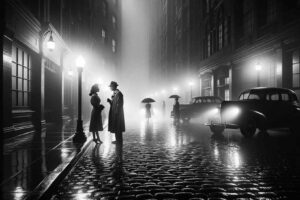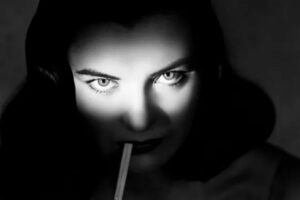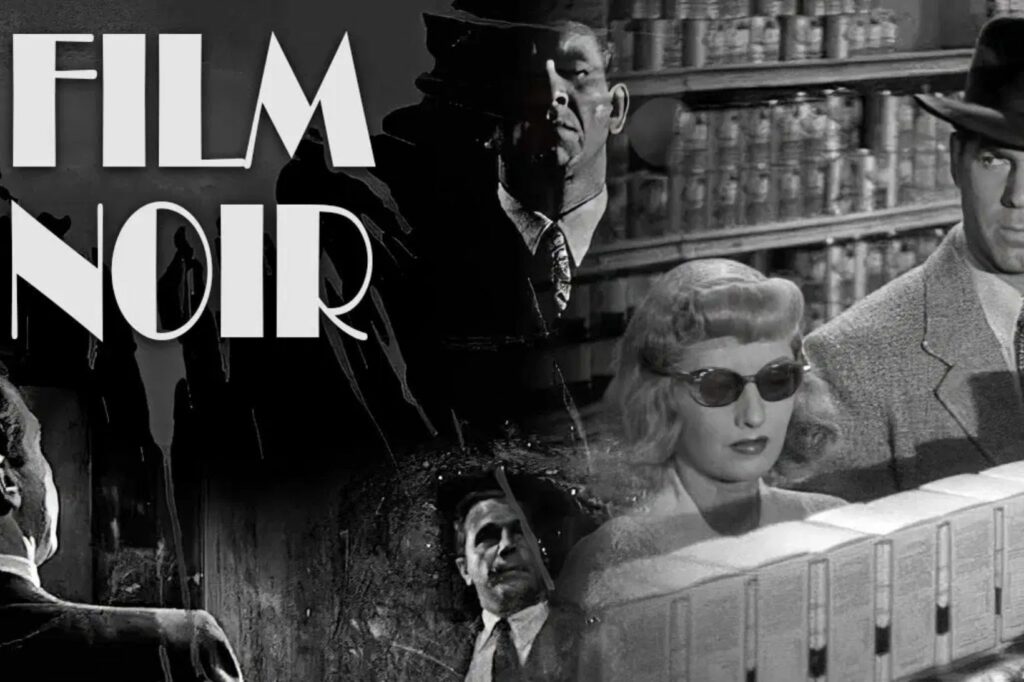Dark alleyways, shadowy figures, and moral ambiguity define the world of film noir cinema. Emerging in the early 1940s, this genre captivated audiences with its gritty storytelling and complex characters. Film noir, often set against a backdrop of post-war disillusionment, offered a stark contrast to the more optimistic narratives of the time, drawing viewers into its murky depths.
Characterized by its distinctive visual style, film noir employs high-contrast lighting and unconventional camera angles to evoke a sense of tension and unease. The genre’s protagonists, often hard-boiled detectives or flawed anti-heroes, navigate a treacherous landscape of crime and corruption.
Film Noir Cinema
 Film noir’s roots trace back to the 1920s and 1930s as German Expressionism influenced Hollywood filmmakers. This movement, marked by moody lighting and stark contrasts, shaped the visual style prominent in noir cinema. During the same period, French poetic realism, which emphasized pessimistic narratives and flawed characters, contributed thematic depth.
Film noir’s roots trace back to the 1920s and 1930s as German Expressionism influenced Hollywood filmmakers. This movement, marked by moody lighting and stark contrasts, shaped the visual style prominent in noir cinema. During the same period, French poetic realism, which emphasized pessimistic narratives and flawed characters, contributed thematic depth.
In the 1940s, the emergence of hard-boiled detective fiction laid a narrative foundation. Authors like Dashiell Hammett and Raymond Chandler created crime narratives rich with cynicism and moral ambiguity, which filmmakers adapted to the screen.
Defining Characteristics
Film noir captivates with its unique blend of visual styles and thematic elements. These defining features distinguish it from other genres, creating an enduring impact on cinema.
Visual Style
Film noir visual style emphasizes moody lighting and stark contrasts. Cinematographers use low-key lighting to cast deep shadows, creating a chiaroscuro effect that heightens tension. Urban settings often serve as backdrops, incorporating rain-soaked streets and smoke-filled rooms to evoke a sense of mystery and danger. These elements mirror noir’s atmospheric and suspenseful storytelling.
Thematic Elements
 Noir’s thematic elements delve into crime, moral ambiguity, and existential despair. Protagonists frequently face ethical dilemmas, navigating a corrupt world where good and evil blur. Storylines typically explore themes of betrayal and fatalism, capturing the mood of post-war anxieties. Characters often grapple with internal conflicts, reflecting the era’s pervasive sense of disillusionment.
Noir’s thematic elements delve into crime, moral ambiguity, and existential despair. Protagonists frequently face ethical dilemmas, navigating a corrupt world where good and evil blur. Storylines typically explore themes of betrayal and fatalism, capturing the mood of post-war anxieties. Characters often grapple with internal conflicts, reflecting the era’s pervasive sense of disillusionment.
Iconic Tropes
Iconic tropes in film noir include hard-boiled detectives and femme fatales. These characters drive the narrative’s complexity, with detectives like Sam Spade embodying cynicism and determination. Femme fatales, alluring yet dangerous women, manipulate and challenge male protagonists, adding layers of intrigue to the plot. Voice-over narration and flashbacks are also common, providing a deeper exploration of the protagonist’s psyche and enhancing the narrative structure.
Notable Films And Directors
Film noir has left an indelible mark on cinema through its iconic films and influential directors. These pioneers crafted films that defined the genre’s aesthetics and narrative style.
Influential Classics
 Several classic films are pivotal in understanding the essence of film noir. “Double Indemnity” (1944), directed by Billy Wilder, presents a quintessential tale of greed and betrayal, featuring Fred MacMurray and Barbara Stanwyck. Another landmark is “The Maltese Falcon” (1941), directed by John Huston, which stars Humphrey Bogart as private detective Sam Spade in a plot of deception and intrigue. “The Big Sleep” (1946), directed by Howard Hawks and also starring Bogart, captures the genre’s complexity and moral ambiguity. “Out of the Past” (1947), directed by Jacques Tourneur, weaves themes of fatalism and lost love with Robert Mitchum and Jane Greer in leading roles.
Several classic films are pivotal in understanding the essence of film noir. “Double Indemnity” (1944), directed by Billy Wilder, presents a quintessential tale of greed and betrayal, featuring Fred MacMurray and Barbara Stanwyck. Another landmark is “The Maltese Falcon” (1941), directed by John Huston, which stars Humphrey Bogart as private detective Sam Spade in a plot of deception and intrigue. “The Big Sleep” (1946), directed by Howard Hawks and also starring Bogart, captures the genre’s complexity and moral ambiguity. “Out of the Past” (1947), directed by Jacques Tourneur, weaves themes of fatalism and lost love with Robert Mitchum and Jane Greer in leading roles.
Key Filmmakers
Several directors have significantly shaped film noir, leaving a lasting legacy on the genre. Billy Wilder, known for “Double Indemnity”, skillfully blends suspense and psychological depth. John Huston’s contribution through “The Maltese Falcon” set a standard for detective narratives. Howard Hawks’ “The Big Sleep” exemplifies effective storytelling and complex character development. Jacques Tourneur, with “Out of the Past”, masterfully combines visual style with narrative sophistication. Additionally, directors like Fritz Lang and Otto Preminger further expanded noir’s stylistic boundaries, enhancing its thematic richness through their respective works.
Endless Fascination for Film
 Film noir has left an indelible mark on the cinematic landscape, capturing the complexities of human nature through its distinctive style and themes. Its enduring influence is evident in modern cinema, where filmmakers continue to draw inspiration from its visual and narrative techniques. By exploring the moral ambiguities and existential dilemmas of its characters, film noir remains a powerful medium for storytelling. As audiences revisit classic noir films and explore neo-noir adaptations, the genre’s legacy continues to resonate, offering fresh insights into the human condition. Film noir’s timeless appeal ensures its place as a cornerstone of cinematic history.
Film noir has left an indelible mark on the cinematic landscape, capturing the complexities of human nature through its distinctive style and themes. Its enduring influence is evident in modern cinema, where filmmakers continue to draw inspiration from its visual and narrative techniques. By exploring the moral ambiguities and existential dilemmas of its characters, film noir remains a powerful medium for storytelling. As audiences revisit classic noir films and explore neo-noir adaptations, the genre’s legacy continues to resonate, offering fresh insights into the human condition. Film noir’s timeless appeal ensures its place as a cornerstone of cinematic history.

